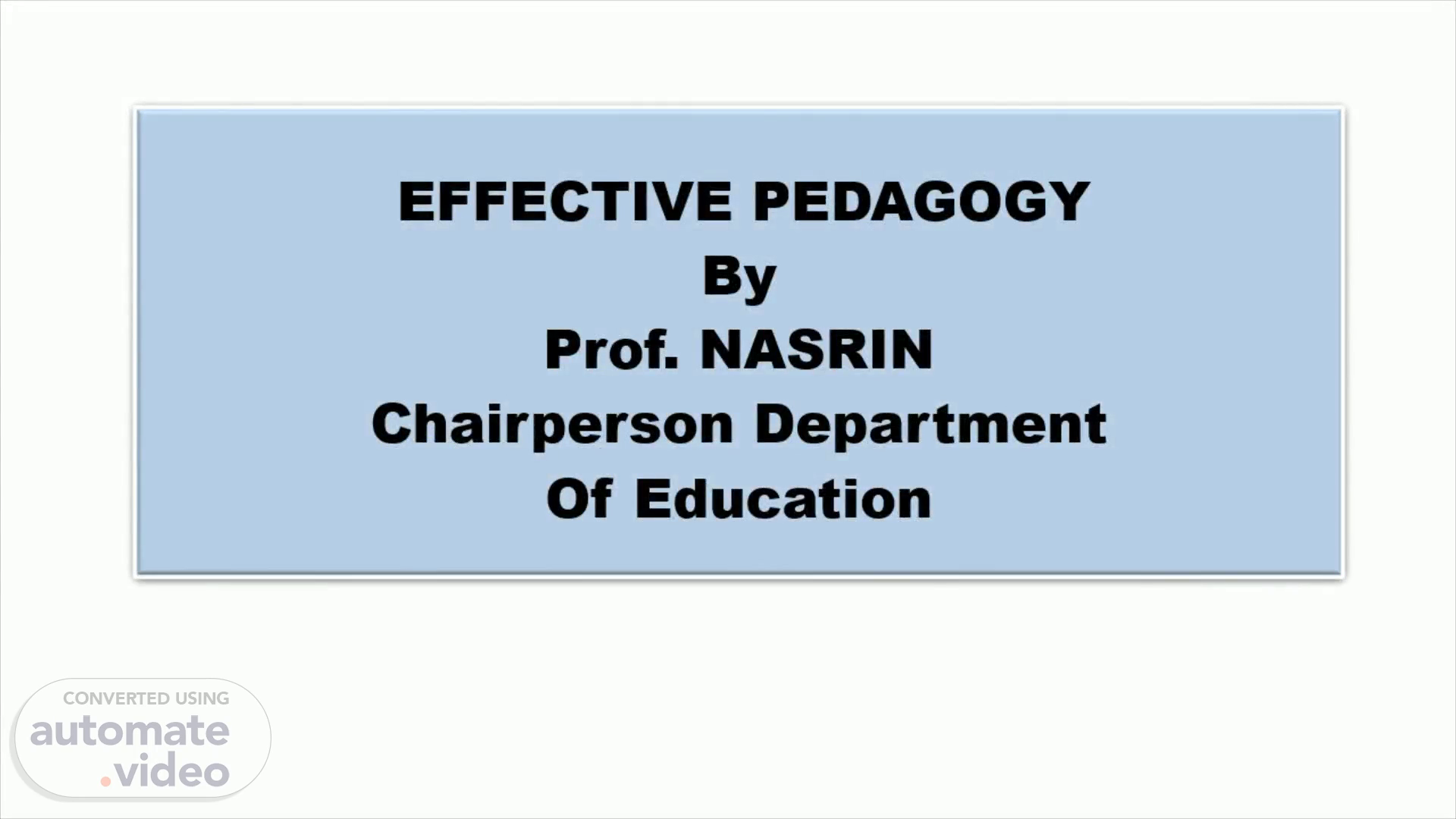
PowerPoint Presentation
Scene 1 (0s)
EFFECTIVE PEDAGOGY By Prof. NASRIN Chairperson Department Of Education.
Scene 2 (7s)
PEDAGOGY. Pedagogy is a word that refers to the art, science, or profession of teaching, and especially to the field of study that deals mainly with methods of teaching and learning in schools . Pedagogy i s the theory and practice of learning, and how this process influences, and is influenced by, the social, political and psychological Development of learners..
Scene 3 (25s)
Pedagogy, taken as an academic discipline, is the study of how knowledge and skills are imparted in an educational context, and it considers the interactions that take place during learning. Both the theory and practice of pedagogy vary greatly, as they reflect different social, political, and cultural contexts. Pedagogy is often described as the act of teaching. The pedagogy adopted by teachers shapes their actions, judgments, and other teaching strategies by taking into consideration theories of learning , understandings of students and their needs, and the backgrounds and interests of individual students..
Scene 4 (52s)
Approaches to Pedagogy. Teacher- Centered: Teacher-Centered learning focuses on the teacher giving lectures and sharing content through direct instruction. It fixates on the knowledge the teacher has and imparting that knowledge to students. Teacher-Centered assessments are cut and dry meant for students to show they know the knowledge that has been shared with them at the end of a unit..
Scene 5 (1m 10s)
Student-Centered Approach: Student-Centered learning directs the student to be an active participant in their own learning process. While the teacher still delivers content, they take on more of a coaching or mentoring role to help students learn. Student-Centered assessments are given more frequently to assess knowledge and tend to be more objective..
Scene 6 (1m 28s)
Technology Based Classroom. High-tech and low-tech approaches refers to how much technology a teacher uses to help teach the content. High-tech includes technology such as Google suite, personal devices, webquests, and apps. Low-tech is more paper-based, like worksheets and hands-on projects..
Scene 7 (1m 44s)
Ways To Improve Your Pedagogy.
Scene 8 (1m 50s)
Dialogue with Yourself through a Teaching Log. Start by writing your lesson plan on the right-hand side of your teaching notebook and reserving the left-hand side for comments and reflection. Questions to ask yourself and reflect on in writing might include, What worked well in this class, and why? What didn’t, and why? Where did the students seem to have difficulties? Were there any noticeable points where the students seemed very engaged with the material? What types of things may need greater clarification the next time? Were there any particular pedagogical strategies that seemed to work well? What will I change the next time I teach this topic?.
Scene 9 (2m 18s)
Solicit Feedback from Your Students. Students can be a great source of feedback on the teaching and learning that takes place in our classrooms on a day-to-day basis. While end-of-semester evaluations tend to summarize the students’ overall responses to the class, this type of input comes too late to be of use to you and your students during the current semester. There are several techniques you can use to solicit ongoing feedback from your students on the class in general or the learning that takes place around specific topics and activities..
Scene 10 (2m 43s)
Dialogue with Faculty. In the pre-observation meeting, you should discuss how the class is going; what you will be teaching and what pedagogical techniques you will be using; your goals for the class period and what you would like the students to take away from the class; and which areas of your teaching you would like feedback on. After the class visit, you should meet with the professors to discuss the class and to set goals for those areas of your teaching that need improvement..
Scene 11 (3m 7s)
Dialogue with Peers. One of your greatest resources for reflecting on and improving your teaching is your peers..
Scene 12 (3m 16s)
Seek Outside Consultation. Consultants are also available to conduct classroom observations and video-recording, together with preparatory and follow-up discussions when these programs are not available in the department..
Scene 13 (3m 28s)
PEDAGOGICAL REFORMS AS PER NEP- 2020. Effective learning requires a comprehensive approach that involves appropriate curriculum, engaging pedagogy, continuous formative assessment, and adequate student support. The curriculum must be interesting and relevant, and updated regularly to align with the latest knowledge requirements and to meet specified learning outcomes. High-quality pedagogy is then necessary to successfully impart the curricular material to students; pedagogical practices determine the learning experiences that are provided to students, thus directly influencing learning outcomes..
Scene 14 (3m 51s)
The assessment methods must be scientific, designed to continuously improve learning and test the application of knowledge. Thus, curriculum, pedagogy, continuous assessment, and student support are the cornerstones for quality learning. Along with providing suitable resources and infrastructure, such as quality libraries, classrooms, labs, technology, sports/recreation areas, student discussion spaces, and dining areas, a number of initiatives will be required to ensure that learning environments are engaging and supportive, and enable all students to succeed..